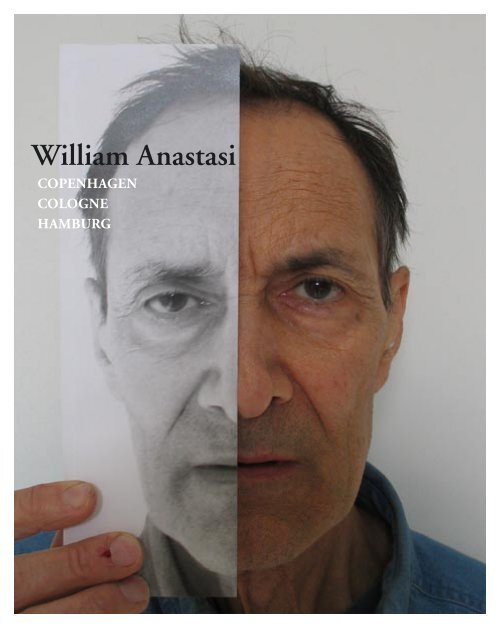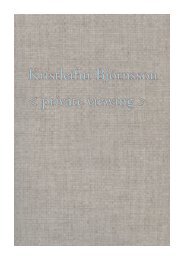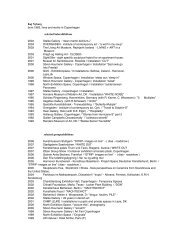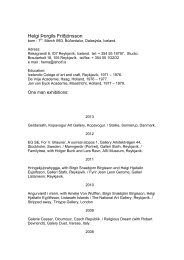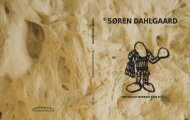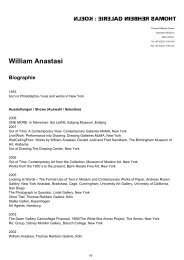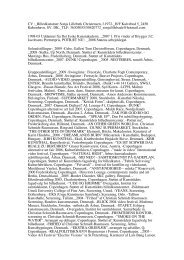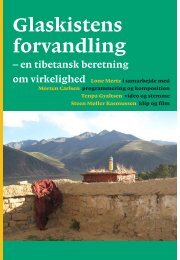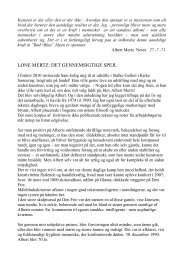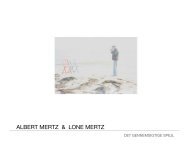William Anastasi - Stalke
William Anastasi - Stalke
William Anastasi - Stalke
Create successful ePaper yourself
Turn your PDF publications into a flip-book with our unique Google optimized e-Paper software.
<strong>William</strong> <strong>Anastasi</strong><br />
COPENHAGEN<br />
COLOGNE<br />
HAMBURG
<strong>William</strong> <strong>Anastasi</strong><br />
STALKE GALLERI<br />
”New paperworks” April 15th - May 19th 2005<br />
<strong>Stalke</strong> Galleri<br />
Vesterbrogade 184<br />
1800 Copenhagen F<br />
Denmark<br />
Phone: +45 3321 1533 or +45 4649 2670<br />
E-mail: stalke@stalke.dk<br />
Website: www.stalke.dk<br />
WILLIAM ANASTASI<br />
Copenhagen - Cologne - Hamburg<br />
All works by <strong>William</strong> <strong>Anastasi</strong><br />
Publisher | <strong>Stalke</strong> Galleri<br />
Text | Jacob Lillemose<br />
Design | Kristian Jakobsen, MOWgrafisk<br />
Print | Trekroner Grafisk A/S<br />
Cover photo | <strong>William</strong> <strong>Anastasi</strong><br />
Photographers | Sam Jedig, bla-bla, bla-bla.<br />
Thank you | Sam Jedig, bla-bla, bla-bla. bla-bla, bla-bla.<br />
bla-bla, bla-bla. bla-bla, bla-bla. bla-bla, bla-bla. bla-bla,<br />
bla-bla. bla-bla, bla-bla..<br />
ISBN 87-90538-24-2<br />
All rights © <strong>Stalke</strong> Galleri and <strong>William</strong> <strong>Anastasi</strong><br />
THOMAS REHBEIN GALLERY<br />
”Without titel”, April 30th - June 21st, 2005.<br />
Thomas Rehbein Gallery<br />
Maria-Hilf-Str. 17<br />
50677 Köln<br />
Germany<br />
Phone: +49 (0) 221 310 10 00<br />
Fax: +49 (0) 221 310 10 03<br />
E-mail: art@rehbein-galerie.de<br />
Website: www.rehbein-galerie.de<br />
ART AGENTS GALLERY<br />
”Blind”, 4th June 2005 - 31th July 2005<br />
Art Agents Gallery<br />
Wilstofer Str. 71, Fabrikhalle Phoenix, Tor 2<br />
21073 Hamburg-Harburg<br />
Germany<br />
Phone: +49 40-8997551 or +49 40-8997552<br />
Website: www.artagents.de<br />
E-mail: info@artagents.de
WILLIAM ANASTASI<br />
<strong>William</strong> <strong>Anastasi</strong><br />
interviewed by Jacob Lillemose<br />
For the show at art agents in Hamburg<br />
you’ll have painters camouflage their<br />
entire gallery, the walls, pipes, fixtures,<br />
everything. A sketch of this idea was shown at<br />
the Thomas Rehbein Gallery in Cologne. Now<br />
there’s the obvious reference to the current<br />
situation in Iraq, the ubiquitous terrorist<br />
threat, the growing feeling that wherever we<br />
turn there’s war. But my understanding is<br />
that the project dates back to the 60’s and<br />
the political atmosphere of that time.<br />
In late 1966 when the US was raining bombs<br />
on Vietnam I offered the camouflage project, in<br />
part, as a response. I proposed a number of other<br />
projects for the Dwan Gallery in New York as<br />
well. Each of these projects involved the idea of<br />
the self-referential – the gallery space would be the<br />
common component of the exhibit. Because the<br />
slot allotted for the exhibition was in the middle<br />
of the exhibition schedule and considerable<br />
time would be needed to return the gallery to<br />
its original state, the camouflage project was<br />
not realized. But the work was finally realized<br />
thirty-six years later. As chance would have it, the<br />
exhibition opened, after a week of preparation,<br />
almost to the day of the US invasion of Iraq.<br />
Months earlier the writer Thomas McEvilley,<br />
sensing the drums of war, reminded Juan Puntes,<br />
director of the White Box Gallery in New York,<br />
about my having proposed camouflaging the<br />
Dwan Gallery in the 60’s. Puntes called me and<br />
asked whether I would exhibit the piece with<br />
them. We met and it was arranged.<br />
My interest in finally realizing this work stemmed<br />
as much from the purely conceptual side of the<br />
idea as from the timely political side of it. To<br />
camouflage the inside of something is a blatant<br />
inversion. Camouflage by any definition is for<br />
the outside of things. In the usual way of looking<br />
at it camouflaging the inside of something is an<br />
absurdity.<br />
Were the other projects also dealing with<br />
political issues<br />
In the art sense of political, absolutely – but not<br />
in the sense of war and peace. I focused on these<br />
self-referential projects most of all as simply works<br />
of art – like all works of art they would be open to<br />
a wide range of responses.<br />
Could you describe some of the other projects<br />
One proposal was to erect vertical and horizontal<br />
chain link fencing twelve inches from every<br />
surface – walls, floor, ceiling, making in effect an<br />
enormous cage within the gallery.<br />
In an obvious way, war is like a cage, isn’t it<br />
Another proposal was to make large photosilkscreen<br />
paintings of the walls on which the<br />
paintings were to be hung. This work would be<br />
CAMOUFLAGE | 1966/2003<br />
4 5
titled Six Sites and it was the exhibition that was<br />
actually mounted. At the time I actually referred<br />
to this exhibit as ”bomb art”. The reference was<br />
to the situation in the 60’s. The US and Russia<br />
both had nuclear weapons, and enough of them<br />
to virtually wipe out human life. This steeped the<br />
Western world, in fact the whole world, in an<br />
understandable paranoia. I thought that maybe it’s<br />
too late for artists to continue skipping through<br />
reality choosing this corner or that to idealize. The<br />
threat of mutual annihilation seemed to make that<br />
quaint, if not archaic. In that sense you could call<br />
this anti-art.<br />
Camouflage – this abstracted and formalized<br />
image of nature – is intended to fool the eye.<br />
Is that what you mean in the title of the work,<br />
Blind<br />
That, and of course, hunters hiding themselves<br />
call that location a blind. And back to war, we<br />
continue blindly going at it despite our solid<br />
knowledge concerning its dependable horror.<br />
Bertolt Brecht has it that war, like love, always<br />
finds a way.<br />
Camouflage placed out of context presented<br />
where it’s never been makes it unnatural in a<br />
different way.<br />
Camouflaging in its usual use makes something<br />
less visible. Doing the same to the inside of<br />
a room would tend to make everything more<br />
visible. Kafka’s aphorism comes to mind: ”You do<br />
not need to leave your room. Remain sitting at<br />
your table and listen. Do not even listen, simply<br />
wait. Do not even wait. Be quite and still and<br />
solitary. The world will freely offer itself to you<br />
to be unmasked, it has no choice, it will roll in<br />
ecstasy at your feet.”<br />
Blindness, although in quite a different sense, is a<br />
significant aspect of your ‘blind’ drawings. These<br />
point to a continuous theme in your work – the<br />
transmission of energy through the hands’ and<br />
arms’ interaction with the physical world. How<br />
did you begin drawing without using your sight<br />
The first of these were dot drawings,<br />
Constellations I called them. Then I did pocket<br />
drawings. I’m currently exhibiting three at <strong>Stalke</strong><br />
Galleri in Copenhagen in a show devoted to<br />
drawings and two from 1969 are concurrently<br />
included in an exhibition at MoMA in New York<br />
called, ”Drawings from the Collection, 1945-<br />
1975”. But their origin began with my love for<br />
silent movies, which I prefer as a genre. I felt a<br />
bit wayward watching so many of them, feeling<br />
it was interfering with my work. This led to my<br />
folding and refolding a piece of paper, sticking it<br />
in my side pants pocket and drawing with a stub<br />
of pencil while watching a silent film at MoMA<br />
or elsewhere. I came to enjoy the idea that my<br />
mind was occupied one place and my hand was<br />
behaving independently. It was a way of drawing<br />
without consulting my aesthetic sense, oblivious,<br />
in fact, to art making, to art in general, to art<br />
history, to myself hopefully. Then I found that<br />
BLIND DRAWING | 2003<br />
6 7
my interest in the activity did not depart after the<br />
lights went on – I would find myself continuing<br />
on the subway ride home. But a hand moving<br />
inside my pocket might be a misdemeanor in<br />
a subway car with other passengers. Necessity<br />
being the mother of invention, I could soon be<br />
found, eyes closed, sitting with a drawing pad<br />
on my lap holding a pencil like a dart in one or<br />
each hand, the point resting on the pad’s surface.<br />
With practice my mind would eventually be as far<br />
from drawing there as it had been at the movies.<br />
I would in time describe this side of my work as<br />
being closer to calisthenics than to aesthetics.<br />
And we know you love calisthenics...<br />
Maybe that’s why I do so many, a little like<br />
an obsession. I wear sound attenuating head<br />
phones. It makes the raucous subway racket<br />
almost ethereal -- and the drawing even more<br />
phenomenological. I am consciously distancing<br />
myself from drawing as I draw.<br />
In this sense the blind drawings are clearly<br />
emblematic of your performative and<br />
instrumental use of the body.<br />
Both my mind and body are getting exercise. I<br />
have always tried to escape my aesthetic prejudice<br />
of the moment. For me the only interesting thing<br />
about taste is that it’s always changing.<br />
Your camouflage project, proposed in 1966 and<br />
first realized at the White Box in 2003, connects<br />
to your other work in the 60’s involving what<br />
you refer to as ”recipes”. There is a significant<br />
NINE POLAROID PHOTOGRAPHS OF A MIRROR COLLECTION: METROPOLITAN MUSEUM OF ART | 1967<br />
8 9
tradition of ”art by instruction” within the<br />
various kinds of conceptual art practiced by Sol<br />
LeWitt, Lawrence Weiner, Robert Barry, among<br />
others.<br />
It’s conceivable that this very project was<br />
suggested to me by an interview of Duchamp by<br />
Dore Ashton published in Studio International<br />
in June 1966. I don’t recall reading that article<br />
when it came out but coming across it years later<br />
wondered whether I might have. Duchamp says:<br />
”Once, many years ago, I was dining with some<br />
artists at the old Hôtel des Artistes here in New<br />
York and there was a huge old-fashioned painting<br />
behind us – a battle scene, I think. So I jumped<br />
up and signed it. You see, that was a ready-made,<br />
which had everything except taste.” Interestingly,<br />
the painting Duchamp thought might have been a<br />
battle scene was actually large nudes but the idea<br />
of battle was in the title.<br />
Wasn’t the camouflage proposal around the same<br />
time as Trespass and Issue<br />
Yes. Both of these pieces have what I call recipes.<br />
For instance, the recipe for Trepass, also from<br />
1966, runs ”Cut perpendicularly, with a mat<br />
knife, to a depth of one-quarter inch the four sides<br />
of a rectangle marked on a plaster wall. With a<br />
rounded, textured stone, comfortable to the grip,<br />
rub firmly and evenly across the delineated area.”<br />
It’s of interest that the camouflage idea calls for<br />
completely covering the wall while Trespass and<br />
Issue call for physically removing a wall’s surface.<br />
And on the subject of recipes the instructions for<br />
Sink of 1963 reads, ”Set a rectangular piece of<br />
hot-rolled carbon steel level on a floor. Pour on it<br />
a measure of tap water so that the resulting pond<br />
holds its position short of overflow. Each time the<br />
water evaporates, repeat.” The surface of the steel<br />
will slowly be invaded by rust whereas the wall’s<br />
surface is quickly invaded in the two other cases.<br />
How did this concept of recipes come to you<br />
The stimulus for Sink and the quite separate<br />
lead-up to the Constellation Drawings each figure<br />
in this. In the case of Sink I had asked a scientist<br />
what in the world rust was about. He said that the<br />
iron ore taken from the mountain was virtually<br />
useless, except maybe as a doorstop – it’s not at<br />
all malleable. When some early genius succeeded<br />
in refining it by heating and skimming off its<br />
impurities we ended up with steel. Things were<br />
now in place for the industrial revolution. But<br />
the steel forever after would be taking from the<br />
moisture in the atmosphere the very elements that<br />
had been removed when it was refined – it´s as<br />
though it has a memory. I remember thinking that<br />
this was the most poetic thing I had ever heard.<br />
Within days I drove to Brooklyn and brought<br />
back a slab of steel, 20 by 20 by one half inch.<br />
The recipe practically wrote itself. In the case of<br />
the Constellations there was no written recipe. I<br />
simply decided to make a dotted blind drawing,<br />
one for each of the ninety-six preludes and fugues<br />
in Bach’s Well Tempered Clavier. As with the first<br />
ISSUE | 1966<br />
10 11
pocket drawings something akin to guilt played<br />
a part. I had just acquired the first ever recording<br />
of the complete work on six long-playing records<br />
that the Polish harpsichordist Wanda Landowska<br />
had recently recorded. I found myself listening<br />
more than I thought was good for me. Since I<br />
often listen to music with eyes closed the idea of<br />
doing a drawing in this state was natural enough.<br />
I found it an intriguing challenge to have the<br />
tapping of the pen point on the pad at odds with<br />
the rhythmic progress of the music. Actually easier<br />
said than done especially with the percussive<br />
sound of a harpsichord. This eventually became<br />
almost a meditation device, a way of separating<br />
the mental process. The ears and the mind were<br />
following the music while the hand was trying to<br />
go its own way.<br />
Sink brings to mind tautology, which is one of<br />
the continuous threads in your work whether<br />
text pieces, objects or photographs. What is<br />
your fascination with the self-referential and the<br />
circular in general<br />
Label of 1967, I guess, is as self-referential as it<br />
gets -- or as site specific if you like that word. I<br />
printed a label that reads, ”<strong>William</strong> <strong>Anastasi</strong>, b.<br />
1933, Label, 1967, type on paper”. Then I printed<br />
another one exactly the same and exhibited them<br />
next to each other. The one on the right was a<br />
work of art, the one on the left was its label. That’s<br />
probably as dumb an idea as I’ve ever had. I used<br />
to say that if something was dumb enough in the<br />
right way, it might be brilliant. This is one of my<br />
early pieces that pops back into my mind from<br />
time to time. I’m of the opinion that every living<br />
organism is only cable of acting in self-interest if<br />
it’s looked at from a sufficient height. A statement<br />
of Darwin’s that I discovered recently is relevant:<br />
”Free will is a delusion caused by our inability to<br />
analyze our own motives.” I have often viewed<br />
”free will” as an amusing oxymoron. All of this<br />
seems to be part of a belief system that somehow<br />
connects with those works of mine that have been<br />
called tautological. I came across Darwin’s remark<br />
at least thirty years after I had titled the closedcircuit<br />
video transmission of a corner of a room<br />
Free Will. I felt that I had a prestigious ally. The<br />
video piece Free Will had been inspired partially<br />
by the same Vietnam debacle that contributed to<br />
the camouflage proposal. The blind individuals<br />
who endorse an aggressive warfare are the very<br />
ones most likely to cling to a moralistic belief<br />
in free will. Probably all of my ”self-referential”<br />
gestures in art are to some extent involved with<br />
my outlook on these questions.<br />
FREE WILL | 1968<br />
12 13
A WORD – WORDS | 1979<br />
READING A LINE ON A WALL | 1967<br />
14 15
XXXXXXXXXXXXXXXXXXXX | 19XX<br />
XXXXXXXXXXXXXXXXXXXX | 19XX<br />
16 17
WORLD MAP | 2003<br />
HAND, POCKET DRAWING | 2005<br />
18 19
SOLO EXHIBITIONS - selected<br />
<strong>William</strong> <strong>Anastasi</strong><br />
born Philadelphia, Pennsylvania, 1933<br />
2005 “Blind” art agents gallery, Hamburg, Germany<br />
“Ohne Titel” Thomas Rehbein Galerie, Köln, Germany<br />
“<strong>William</strong> <strong>Anastasi</strong>” <strong>Stalke</strong> Kunsthandel,<br />
Copenhagen, Denmark<br />
2003 “Blind” The Annex, NY<br />
2001 “<strong>William</strong> <strong>Anastasi</strong>: A Retrospective”<br />
Nikolaj Copenhagen Contemporary Art<br />
Center, Copenhagen, Denmark<br />
2000 art agents Gallery, Hamburg<br />
1999 “...vor mehr als einem halben Jahrhundert,”<br />
Landes Museum, Linz, Germany<br />
Gary Tatintsian Gallery, NY<br />
1998 “I Am A Jew,” The Philadelphia Museum of Judaica,<br />
Philadelphia, PA<br />
1997 “The Painting of the Word Jew,”<br />
Sandra Gering Gallery, NY<br />
Hubert Winter Gallery, Vienna, Austria<br />
1996 <strong>Stalke</strong> Kunsthandel, Copenhagen, Denmark<br />
1995 “<strong>William</strong> <strong>Anastasi</strong>: A Retrospective (1960-95)”,<br />
Moore College of Art and Design, Philadelphia, PA<br />
1989 ”A Selection of works from 1960 to 1989”,<br />
The Scott Hanson Gallery, New York<br />
1988 <strong>Stalke</strong> Galleri, Kopenhagen<br />
1987 Bess Cutler Gallery, New York<br />
1982 ”Diary Paintings”, Ericson Gallery<br />
1981 ”Coincidents”, The Whitney Museum of<br />
American Art, New York<br />
1979 ”Re-visions: Perspectives and Proposals in Film and<br />
Video”, The Whitney Museum of American Art,<br />
New York<br />
”Coincidents”, Kunstmuseum Düsseldorf, Düsseldorf<br />
Max Hetzler, Stuttgart<br />
1978 ”Terminus”, The Hudson River Museum, New York<br />
1977 P.S.1 Museum, The Institute of Art and<br />
Urban Resources, New York<br />
1973 0. K. Harris Gallery, New York<br />
1970 ”Continuum”, Dwan Gallery, New York<br />
1967 ”Six Sites”, Dwan Gallery, New York<br />
1966 ”Sound Objects”, Dwan Gallery, New York<br />
1965 Witherspoon Gallery,<br />
University of North Carolina<br />
1964 Washington Square Gallery, New York<br />
”Abandoned Paintings”,<br />
Sandra Gering Gallery, New York<br />
1993 ”Du Jarry”, Sandra Gering Gallery, New York<br />
”Drawing Sounds: An Installation in Honor of John<br />
Cage”, The Philadelphia Museum of Art, Philadelphia<br />
1992 ”Works 1963-1992”, Anders Tornberg Gallery, Lund<br />
DIPTYCH, SELFPORTRAIT | 1967/2000<br />
Collection af Merce Cunningham<br />
1991 ”Sink, Trespass, Issue, Incision”,<br />
Sandra Gering Gallery, New York<br />
20 21
GROUP EXHIBITIONS - selected<br />
2003 The Invisible Thread: Buddhist Spirit in<br />
Contemporary Art, Snug Harbor, New<br />
YorkDavidson Art Gallery, Wesleyan University,<br />
Middletown, USA<br />
2001 Visions From American Art: Photographs from<br />
the Whitney Museum of American Art, 1940-<br />
2000, The Whitney Museum of American Art,<br />
New York<br />
2000 Into the Light: The Projected Image in American<br />
Art 1964-1977, The Whitney Museum of<br />
American Art, New York; curated by Chrissie Iles<br />
“The American Century, 1950-2000,” The<br />
Whitney Museum of American Art, NY<br />
1999 Merce Cunningham: Fifty Years,<br />
La Fundacio Antoni Tapiès, Barcelona, Spain<br />
Afterimage, curated by Connie Butler,<br />
Museum of Contemporary Art, Los Angeles<br />
1998 Drawing is another kind of language: Recent<br />
American drawings from a New York private<br />
collection, Kunstmuseum Ahlen, Ahlen, Germany<br />
Re:Duchamp/Contemporary Artists Respond to<br />
Marcel Duchamp’s Influence,<br />
Abraham Lubelsky Gallery, NY<br />
1997 Drawing is another kind of language: Recent<br />
American drawings from a New York private<br />
collection, Harvard University, Sackler Gallery,<br />
Cambridge, MA<br />
1995 ”Sound Sculpture: Music for the Eyes”,<br />
Ludwig Museum, Koblenz<br />
”Joyce and the Visual Arts”,<br />
The Rosenbach Museum & Library, Philadelphia<br />
”Dark Room”, Stark Gallery, New York<br />
1994 ”Drawings” (with Dove Bradshaw),<br />
Werner H. Kramarsky, New York<br />
”Autobodyography” (with Dove Bradshaw),<br />
Sandra Gering Gallery, New York<br />
1993 ”Rolyholyover: A Circus” (curated by John<br />
Cage and Julie Lazar), MOCA, Los Angeles,<br />
Le Centre Pompidou, Paris, The Guggenheim<br />
Museum, New York, The Philadelphia Museum<br />
of Art, Mito Art Tower, Mito, Japan<br />
1991 ”imitating nature in her manner of operation...”<br />
(with Dove Bradshaw, John Cage, Tom Marioni,<br />
Robert Rauschenberg, Mark Tobey),<br />
Sandra Gering Gallery, New York<br />
1989 The Leo Castelli Gallery,<br />
Performing Arts Benefit<br />
1988 ”Benefit for Contemporary Performance<br />
Arts Inc.”, Leo Castelli Gallery, New York<br />
<strong>Stalke</strong> Galleri, Kopenhagen<br />
1987 ”Reading Art”, The New Museum of<br />
Contemporary Art, New York<br />
1982 ”Annual Awards”, The American Academy<br />
of Arts and Letters, New York<br />
”Exhibition in Honor of John Cage”, The<br />
American Center, Paris<br />
1981 ”Biennial ’81”, The Whitney Museum of<br />
American Art, New York<br />
1980 ”Film as Installation”, The Clocktower, New York<br />
”Für Augen und Ohren”, Akademie der Künste, Berlin<br />
”Ecoute par les Yeux”, Musee D’Art Moderne de<br />
la Ville de Paris<br />
1979 ”Sound”, P.S.1 Museum, Long Island City<br />
”Terminus”, The Hudson River Museum, New York<br />
”Benefit for Contemporary Performance Arts”,<br />
Leo Castelli Gallery, New York<br />
1978 Paula Cooper Gallery, New York<br />
Anna Canepa, Video Distribution, New York<br />
”Couples”, P.S. 1 Museum, Long Island City<br />
The Georgia Museum of Art, Athens, Georgia<br />
UNTITLED | 1966<br />
One gallon of industrial high-gloss enamel, throw Diminsion vary<br />
22 23
<strong>William</strong> <strong>Anastasi</strong><br />
ISBN 87-90538-24-2


